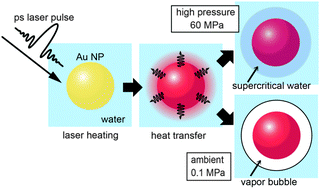Laser-driven phase transitions in aqueous colloidal gold nanoparticles under high pressure: picosecond pump–probe study†
Abstract
Pump–probe transient extinction spectroscopy was used to analyze 355 nm picosecond laser heating-induced phenomena in 60 nm-diameter aqueous gold nanoparticles (AuNPs) under a high pressure of 60 MPa. Kinetic spectroscopy revealed that a supercritical layer surrounding the AuNP nucleated with a lifetime of approximately 1 ns during its dynamic expansion and decay for a fluence of 19.6 mJ cm−2. Moreover, in the post-mortem transmission electron micrographs we observed a number of fragments, a small percentage of size-reduced cores, and erupted particles among the intact particles after 60 shots, suggesting that evaporation occurred under laser illumination. The particle temperature calculation indicated that evaporation begins with a liquid droplet AuNP surrounded by a supercritical layer at temperatures below the boiling point of gold. By applying high pressure, we obtained a clear picture of the evaporation event, which was not possible at ambient pressure because bubble formation caused particle temperatures to rise uncontrollably. In this study, we shed light on the critical role of the supercritical layer formed around the AuNP under high pressure during laser-induced evaporation.


 Please wait while we load your content...
Please wait while we load your content...